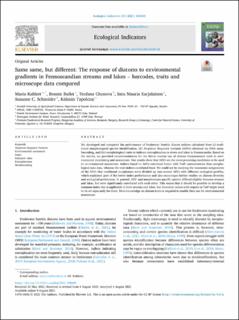| dc.contributor.author | Kahlert, Maria | |
| dc.contributor.author | Bailet, Bonnie | |
| dc.contributor.author | Chonova, Teofana | |
| dc.contributor.author | Karjalainen, Satu Maaria | |
| dc.contributor.author | Schneider, Susanne C. | |
| dc.contributor.author | Tapolczai, Kálmán | |
| dc.date.accessioned | 2021-12-10T12:25:43Z | |
| dc.date.available | 2021-12-10T12:25:43Z | |
| dc.date.created | 2021-11-11T11:10:15Z | |
| dc.date.issued | 2021 | |
| dc.identifier.citation | Ecological Indicators. 2021, 130, 108088. | en_US |
| dc.identifier.issn | 1470-160X | |
| dc.identifier.uri | https://hdl.handle.net/11250/2833792 | |
| dc.description.abstract | We developed and compared the performance of freshwater benthic diatom indices calculated from (i) traditional morphological species identification, (ii) Amplicon Sequence Variants (ASVs) obtained via DNA metabarcoding, and (iii) morphological traits to indicate eutrophication in rivers and lakes in Fennoscandia. Based on the results, we provided recommendations for the future routine use of diatom bioassessment tools in environmental monitoring and assessment. Our results show that ASVs are the most promising candidates to be used in environmental assessment. Indices based on ASVs correlated better with TotP concentrations than morphological taxa data, whereas the trait indices correlated least. We could see by studying the taxonomic assignments of the ASVs that traditional morphotaxa were divided up into several ASVs with different ecological profiles, which explained part of the better index performance and also encourages further studies on diatom diversity and ecological preferences. In general, ASV- and morphotaxon-specific optima differed slightly between streams and lakes, but were significantly correlated with each other. This means that it should be possible to develop a common index that is applicable in both streams and lakes, but boundary values with respect to TotP might need to be set separately for them. More knowledge on diatom traits is required to enable their use for environmental assessment. | en_US |
| dc.language.iso | eng | en_US |
| dc.publisher | Elsevier | en_US |
| dc.rights | Navngivelse 4.0 Internasjonal | * |
| dc.rights.uri | http://creativecommons.org/licenses/by/4.0/deed.no | * |
| dc.title | Same same, but different: The response of diatoms to environmental gradients in Fennoscandian streams and lakes – barcodes, traits and microscope data compared | en_US |
| dc.type | Peer reviewed | en_US |
| dc.type | Journal article | en_US |
| dc.description.version | publishedVersion | en_US |
| dc.rights.holder | © 2021 The Authors. | en_US |
| dc.source.pagenumber | 12 | en_US |
| dc.source.volume | 130 | en_US |
| dc.source.journal | Ecological Indicators | en_US |
| dc.identifier.doi | 10.1016/j.ecolind.2021.108088 | |
| dc.identifier.cristin | 1953604 | |
| dc.source.articlenumber | 108088 | en_US |
| cristin.ispublished | true | |
| cristin.fulltext | original | |
| cristin.qualitycode | 1 | |

